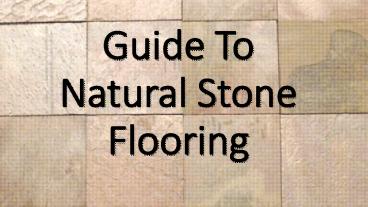Guide to natural stone and flooring - PowerPoint PPT Presentation
Title:
Guide to natural stone and flooring
Description:
Among flooring materials, none is more elegant and luxurious than natural stone. The term "natural stone" refers to a variety of mountain-born mineral substances that stand in contrast to any synthetic or manufactured stone products. Common natural stone flooring includes slate, marble, limestone, travertine, granite, and sandstone—each of which has slightly different properties. It's important to understand the characteristics of the type of stone flooring tile you are purchasing in order to determine whether it is appropriate for a specific location. – PowerPoint PPT presentation
Number of Views:55
Title: Guide to natural stone and flooring
1
Guide To Natural Stone Flooring
2
- Among flooring materials, none is more elegant
and luxurious than natural stone. The term
"natural stone" refers to a variety of
mountain-born mineral substances that stand in
contrast to any synthetic or manufactured stone
products. Common natural stone flooring includes
slate, marble, limestone, travertine, granite,
and sandstoneeach of which has slightly
different properties. It's important to
understand the characteristics of the type of
stone flooring tile you are purchasing in order
to determine whether it is appropriate for a
specific location.
3
Absorption Rating
- The absorption rating refers to how porous a
given material is. The more absorbent it is, the
more susceptible it will be to stains, as well as
cracking damage when subjected to freezing
conditions. Natural stones vary greatly in their
absorption rates, with sandstone being the most
porous to granite, which is virtually waterproof
even when left unsealed. Absorption rate will be
classified according the following terms - Non-vitreous This is the highest absorption
level. In most cases, non-vitreous tiles should
not be used in any damp environment.
4
- Semi-vitreous While these tiles are less
absorbent, the more liquid they are exposed to,
the more maintenance they will require. - Vitreous This is the standard absorption level
for flooring tiles and these materials are
generally considered appropriate for most low to
mid traffic indoor and outdoor applications. - Impervious These materials are resistant to the
absorption of liquids and thus will be easier to
maintain. They are often used in high-traffic
commercial applications.
5
- In general, sandstone is the most porous natural
stone material. Travertine, limestone, and slate
have medium absorbency, while granite
is relatively waterproof. - Polished materials also absorb less water than
honed or cleft surfaces.?
6
Grade
- Some retailers use a grading system to rate the
quality of materials. This can refer to the size,
shape, and thickness of the tile, as well as the
condition of its surface. Most grading systems
have three levels of quality. - Grade 1 refers to high quality, uniform
materials. - Grade 2 consists of materials with minor defects,
such as chips, scratches, or irregular surfaces. - Grade 3 materials have major flaws in size,
shape, surface, or chipping, making them
appropriate only as accent pieces, or in certain
rustic decorative applications.
7
Coefficient of Friction
- This measures how slippery various materials are.
The higher the coefficient, the more traction a
tile will have. This number is especially
important in moist environments such as bathrooms
and kitchens, as well as high- traffic commercial
areas. The Americans with Disabilities Act
requires that flooring material has a minimum of
a .6 dryness coefficient.
8
Indoor vs. Outdoor Rating
- Some natural stone flooring materials are more
suited to outdoor applications than others. Many
of the factors above will determine whether a
material should be used in an open air
environment. - Non-vitreous materials will be subject to
staining through dirt and acid rain, as well as
cracking when absorbed materials freeze and
expand. Stones which have a low coefficient of
friction will also pose a slipping hazard during
rain and snow storms.
9
Oxidation
- Natural stone materials are formed beneath the
earth over millions of years, and often contain a
variety of disparate elements. Sometimes iron is
present in these materials, which can manifest as
bright red and amber hues in the surface of the
stone. The problem in an outdoor environment is
that those traces of iron can oxidize, a process
more commonly known as rusting. This can cause
the entire tile to degenerate over time.?
10
Benefits of Using Natural Stone Flooring
- There are many aesthetic and practical reasons
why natural stone flooring can be a good choice - Each piece of stone is a unique creation of the
earth, making every flooring application one of a
kind. Every floor is entirely unique. - The mountain-born qualities of the stone can help
to give living spaces a direct and eternal
connection to the natural world, unlike any other
building material. - While there is some debate about the ecological
impact of quarrying and transporting stone
materials, the tiles themselves are natural,
nonpolluting, eco-friendly pieces. Purchasing
stones which were acquired locally can cut down
on the environmental impact of transport.
11
Drawbacks of Using Natural Stone Flooring
- There are also some drawbacks to the use of
natural stone - With the exception of granite and some slate,
natural stone is quite porous and needs to be
treated with a sealing agent periodically to
protect its surfaces. - Some polished materials such as marble can
scratch easily. - Some stones are also very brittle and will chip
easily. - When purchasing natural stone flooring materials
it is important to do your research and
understand the characteristics of the material
you are purchasing. Find out whether it is
appropriate for your specific application and how
much maintenance it will require. Ask your
retailer multiple questions, and get to know the
material as much as you can before you make a
purchase.
12
Natural stone flooring
- Natural Stone TR. L.L.C SharjahP.O.Box.
69128United Arab Emirates971 6 5352252 971
564081731 contactus_at_naturalstoneuae.com































